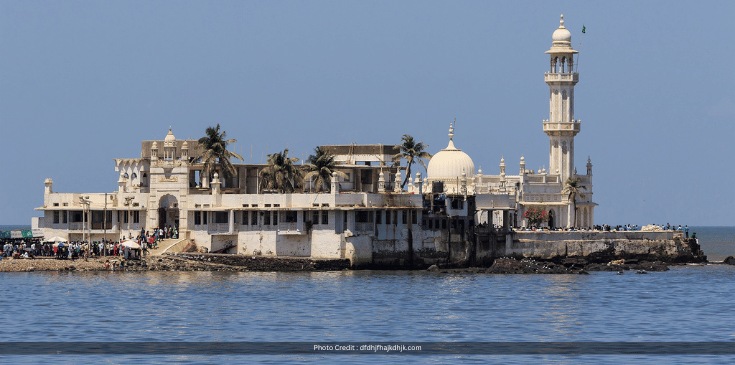
Haji Ali Dargah
Haji Ali Dargah: Peaceful Spot by the Sea in Mumbai!
Nestled within the bustling cityscape of Mumbai, Haji Ali Dargah emerges as a unique and spiritually significant monument, standing on an islet in the Arabian Sea. This detailed exploration delves into the historical roots, architectural intricacies, spiritual importance, cultural significance, annual celebrations, and ongoing preservation efforts surrounding this iconic landmark.
History and Origin: In the 15th century, a prosperous merchant named Haji Ali Shah Bukhari embarked on a transformative pilgrimage to Mecca, forsaking his wealth. Legend has it that he met an untimely demise during the journey, and miraculously, his coffin drifted to the spot where Haji Ali Dargah now stands. In honor of his memory and the symbolic significance of his resting place, the people of Mumbai erected the shrine as a tribute to faith and sacrifice.
Architectural Splendor: Haji Ali Dargah's architectural brilliance is a testament to the fusion of Indian and Arabian styles. Crafted from pristine white marble, the structure features elaborate latticework, domes, and minarets. During high tide, the pathway leading to the dargah submerges, creating an illusion that the shrine is afloat on the Arabian Sea, adding to its mystical allure.
Spiritual Significance: Beyond its architectural grandeur, Haji Ali Dargah holds profound spiritual importance. Devotees from various religious backgrounds converge to seek blessings, offer prayers, and experience the tranquil atmosphere permeated with the soul-stirring melodies of qawwalis. Many believe that the dargah possesses the divine power to fulfill their wishes and bring solace to troubled hearts.
Cultural Harmony: A hallmark of Haji Ali Dargah is its inclusive environment, welcoming individuals of all faiths. This harmonious coexistence is visible as Hindus, Muslims, and people from diverse backgrounds join hands in prayer, showcasing Mumbai's cultural amalgamation and the dargah's role as a symbol of unity.
Festivals and Celebrations: The annual Urs festival is a vibrant celebration at Haji Ali Dargah, marking the death anniversary of Haji Ali. The shrine comes alive with ornate decorations, shimmering lights, and the resonant echoes of special prayers and ceremonies. Pilgrims from across the nation gather to partake in the festivities, fostering a sense of community and shared spirituality.
Preservation Efforts: While the dargah stands as a beacon of history and faith, it faces challenges from coastal erosion and rising sea levels. In response, concerted efforts from governmental and non-governmental entities are underway to preserve this cultural treasure. Restoration initiatives aim to safeguard the structural integrity of Haji Ali Dargah while maintaining its historical and spiritual significance.
How To Reach Haji Ali Dargah
Reaching Haji Ali Dargah By Bus:
Mumbai boasts an extensive bus network, making it accessible for those opting for this mode of transportation. From various parts of the city, buses ply to the area near Haji Ali Dargah. The bus stops closest to the shrine include Tardeo and Mahalaxmi. Depending on your location, you can board buses from the Brihanmumbai Electric Supply and Transport (BEST) network, ensuring a budget-friendly and straightforward journey.
Reaching Haji Ali Dargah By Train:
Mumbai's local train system is the lifeline of the city, connecting distant suburbs to the heart of Mumbai. To reach Haji Ali Dargah by train, the nearest railway stations are Mahalaxmi and Mumbai Central. From either station, you can hire a taxi, take a bus, or enjoy a leisurely stroll to the dargah, immersing yourself in the vibrant cityscape.
Reaching Haji Ali Dargah By Air:
For those traveling from distant locations, reaching Mumbai by air is a convenient option. Chhatrapati Shivaji Maharaj International Airport serves as the city's primary gateway. From the airport, you can hire a taxi or use ride-sharing services to reach Haji Ali Dargah directly. The journey provides glimpses of Mumbai's bustling streets, allowing you to soak in the city's energy.
Haji Ali Dargah Timings
Before delving into the ideal moments for a visit, let's familiarize ourselves with the consistent schedule at Haji Ali Dargah:
Monday to Sunday: 5:30 am – 10:00 pm
These timings ensure that the dargah remains accessible throughout the week, offering ample opportunities for devotees and tourists to immerse themselves in its spiritual aura.
Best Times to Visit:
Early Mornings (5:30 am – 7:00 am): The dawn hours unveil a tranquil and undisturbed atmosphere. Early risers can relish the calmness, engage in personal prayers, and witness the sun casting a gentle glow on the dargah and the surrounding Arabian Sea. This time is perfect for a reflective and peaceful experience.
Weekdays (Monday to Thursday): To avoid the weekend crowds, weekdays are preferable for a more contemplative visit. The dargah exudes a quieter charm during these days, allowing visitors to explore its architectural beauty and connect with the spiritual energy without the bustling weekend activity.
Late Afternoons (4:00 pm – 6:00 pm): As the day progresses, late afternoons offer a pleasant climate. Visitors can explore the dargah's intricate details and enjoy the scenic views without the intensity of the midday sun. The soft light during this time adds a serene touch to the experience.
Fridays for Jumu'ah Prayers: For those seeking an immersive cultural and religious experience, Fridays hold special significance. The Jumu'ah prayers draw worshippers, creating a unique and spiritually charged environment. It's advisable to plan accordingly if you wish to partake in this sacred tradition.
Considerations for Special Occasions:
During festivals, Urs celebrations, or other special events, the dargah may extend its timings or experience increased footfall. Checking for any event-specific details before planning your visit ensures you can align your pilgrimage with the cultural richness and vibrancy of these occasions.
Conclusion
Haji Ali Dargah, with its intricate history, architectural grandeur, spiritual resonance, cultural inclusivity, festive celebrations, and ongoing preservation efforts, stands as a testament to Mumbai's rich tapestry. As a spiritual oasis amidst the Arabian Sea, it continues to draw people from all walks of life, offering a timeless connection to faith, history, and unity in the heart of India's vibrant metropolis.
